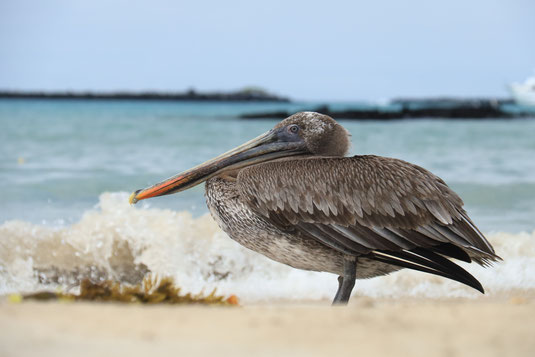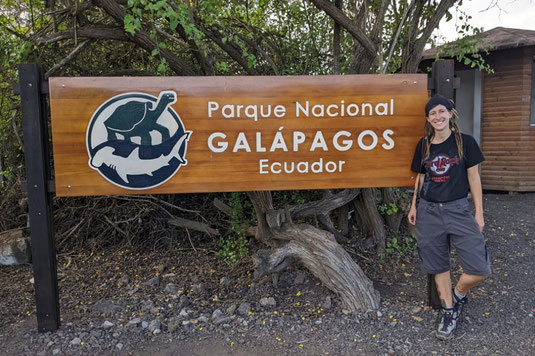More than giant Tortoises - A thought-provoking Trip to the Galapagos Islands.
January 21, 2023

There are three things about the Galapagos Islands that almost everyone has thought at one time or another: They lie somewhere in one of the seven oceans, they have giant turtles, they were once in some PBS documentary.
To me they were always something like Easter Island or Polynesia: so far away that even if you've heard of them, you'll never get there.
As we plan our roadtrip through Ecuador, we notice the small, colorful dots in the middle of the sea on the map. Fact - the Galapagos Islands are part of Ecuador!
"While we're there...!", I say seriously to my boyfriend.
Now that's relative, because between Ecuador's capital, Quito, on the continent, and the islands lies a whopping 825 miles, most of which is ocean. But who knows when we'll get another chance to be so close. In my case, it's 6,550 miles from my home in Germany to the Galapagos Islands.
And so, toward the end of our three-week trip through Ecuador, we are sitting in a plane over the Pacific. On our way to see giant tortoises, un-penguins, lava tunnels and the question of what we humans are doing to a unique nature.
Galapagos facts: 97% national park and rain in the dry season

As we approach the islands, first thing we see is a brown blob in turquoise water. Huh, aren't the islands green and full of wildlife? Am I confusing this with the last PBS documentary I saw about the Amazon?
There are no classic seasons on the Galapagos Islands because they are too close to the equator. Instead, there are rainy and dry seasons. Right now, in October, it's the dry season. Madness! But the withered country under us explained itself almost immediately.
In the rumbling bus that takes us from the airport to the coastal town of Puerto Ayora on the island of Santa Cruz, we first pass through steppe country with tree-like cacti and then we enter into surprisingly lush, green forests. Dude, what's up with this supposed dry season? Oh well, it's still raining in the mountains, even in the dry season.
From the very first contact with this extraordinary place, there's a lot for the human cerebrum to process.
According to UNESCO, the Galapagos archipelago consists of 127 individual islands and rocks. Since 1959, 97% of the area has been a national park. Humans are only allowed to use three percent of the land for homes and agriculture—and only on four of the islands. That’s pretty good! Surrounding the islands is the Galapagos Marine Reserve, which was expanded in 1998 to 51,350 square miles, making it one of the largest protected areas in the world. Again, pretty good!
Why do I say this?
Saving the Paradise - Conservation on the Galapagos Islands

After just one day in the Galapagos, we are struck by the immense effort that is being made by scientists and conservationists to study and preserve the island plant and animal life. I have never seen such an effort on such a scale in any other place in the world. It is remarkable, it is truly inspiring, and it shows how fragile, unique, and precious our earth is. There are hatcheries for giant tortoises, reintroduction programs, labs devoting research to combat invasive plant and animal species, rescue stations for iguanas, as well as countless scientific studies being conducted, observation areas, guides, education centers, and restrictions on where you can go and what you can do.
But why all this in the first place?
Damage control. When the first humans landed on the islands 500 years ago, they inadvertently brought rats and purposely introduced goats to the islands, both of which ate the eggs and food of native animals. They killed whales. They captured the giant tortoises and put them alive in dark holds on their ships. They contaminated the sea with oil, and they spread foreign plant seeds that overgrew everything. And these are just the things that come immediately to mind.
Ah, humans.
Tourism, yes or no?

And even if much of this inadvertent destruction has stopped, and the islands reforested and nurtured, the question is what changes do current travelers, like me, do by visiting the islands?
Every year 275,000 tourists visit the Galapagos, spending millions of dollars. Money that finances the local economy, research, and conservation efforts, as a guide tells us. But we tourists are also responsible for creating exhaust fumes, garbage, hotel construction, and environmental misbehavior. To prevent visitors from trampling everything on this fragile ecosystem, the islands have very few roads and hiking trails. Many of them you are not allowed to enter without a guide. Those who think they will come and roam freely through a paradise on the Galapagos Islands are mistaken. Humans must protect nature from themselves.
What do you think—should one travel to such places at all, or simply leave it alone? Can you weigh the advantages and disadvantages? Even locals and conservationists are uncertain as to what is best—and so am I.
Experience Galapagos: What to see and do

During our short time on the Galapagos Islands—and you should plan on spending at least three days, even if you feel like you must rob a bank to afford it—we visit several breeding stations for the famous giant tortoises. It's incredible to see the tiny animals crawling around, which one day become Methuselahs over a hundred years old. Imagine living 175 years and all you do is eat grass. Sounds almost like meditation in today's fast-paced world.
On a boat tour to Isabela Island, we try to spot penguins. The Galapagos penguin, like many animals and plants here, is endemic to the islands. This means it is found exclusively on the Galapagos Islands and nowhere else in the world. We see blue-footed boobies, little hammerhead sharks and black sea lizards. I try very hard to spot penguins, but again and again what I see just ends up being a black lava rock topped with bird poop. Alas. There are no penguins to be seen on this trip, but this is nature and not an entertainment program.
For unknown reasons I go snorkeling in 65-degree water. Oh well, it used to be 65 degrees during summer vacations at the North Sea in Germany. Can't be so bad. I see colorful fish, a sea turtle, and finally swim directly over the hammerheads. Despite wearing a wetsuit, after twenty minutes I can no longer feel my hands and feet.
"Is it cold?" someone asks from the boat with a broad and innocent smile as I climb back aboard. People in Greenland send me text
messages complaining about the noise from my chattering teeth. Half an hour later I still have problems keeping my fork horizontal with my numb fingers in the restaurant where we
stop for lunch.

Not only the animals are unbelievably great and approachable—seals lie lazily on the sidewalks in the pedestrian zone, pelicans sit unruffled in bushes right next to the harbor, bright red crabs almost run over your feet—but the geology is also astoundingly wonderful. Not simply old rocks behind a glass case in a museum, but wacky stuff like lava tunnels and sunken volcanic craters.
One of the few hiking trails that you are allowed to enter without a guide leads around the Los Gemelos craters, which are not true volcanic craters at all, but pits formed by the collapse of empty magma chambers. I feel like I’m in the movie Jumanji. Moss hangs everywhere from the trees, colorful birds chirp, huge flowers tower in the path. Not far away are several lava tunnels that you can walk through.
Yes, there is a lot to see and do in the Galapagos. Many natural wonders, many problems, many conservation programs. I was impressed by the diversity of species, the surreal beauty of volcanic nature, and the great and frequently very successful efforts of conservationists. A trip to the Galapagos is a trip that definitely makes you think, that gives you a little more confidence for the future, and yet leaves many questions unanswered when you leave.
Find more about our roadtrip through Ecuador and our adventure in the Amazon here:





